The local news landscape in America is going through profound changes as both news consumers and producers continue to adapt to a more digital news environment. We recently asked U.S. adults about the ways they access local news, as well as their attitudes toward local journalism, finding that:
- A growing share of Americans prefer to get local news online, while fewer are getting news on TV or in print. And newspapers are no longer primarily consumed as a print product – the majority of readers of local daily newspapers now access them digitally.
- The share of U.S. adults who say they are paying close attention to local news has dropped since our last major survey of attitudes toward local news in 2018, mirroring declining attention to national news.
- Americans still see value in local news and local journalists. A large majority say local news outlets are at least somewhat important to the well-being of their local community. Most people also say local journalists are in touch with their communities and that their local news media perform well at several aspects of their jobs, such as reporting the news accurately.
- At the same time, a relatively small share of Americans (15%) say they have paid for local news in the last year. And many seem unaware of the major financial challenges facing local news: A 63% majority (albeit a smaller majority than in 2018) say they think their local news outlets are doing very or somewhat well financially.
- Majorities of both major parties say local media in their area are doing their jobs well. While Republicans and GOP-leaning independents are slightly less positive than Democrats and Democratic leaners in their opinions of local media, views of local news don’t have the same stark political divides that exist within Americans’ opinions about national media.
- Most Americans say local journalists should remain neutral on issues in their community, but a substantial minority say local journalists should take a more active role. About three-in-ten say local journalists should advocate for change in their communities, a view that’s especially common among Democrats and younger adults.
These are some of the key findings from a new Pew Research Center survey of about 5,000 U.S. adults conducted in January 2024. This is the first in a series of Pew Research Center reports on local news from the Pew-Knight Initiative, a research program funded jointly by The Pew Charitable Trusts and the John S. and James L. Knight Foundation.
Americans largely hold positive views of local news organizations
At a time when many local news outlets are struggling and Americans’ trust in the news media has waned, the vast majority of U.S. adults (85%) say local news outlets are at least somewhat important to the well-being of their local community. This includes 44% who say local journalism is extremely or very important to their community
About seven-in-ten U.S. adults (69%) say that local journalists in their area are mostly in touch with their community, up from 63% who said this in 2018. And most Americans also say their local news organizations are doing well at four key roles:
- Reporting news accurately (71%)
- Covering the most important stories (68%)
- Being transparent (63%)
- Keeping an eye on local political leaders (61%).
These are relatively positive views compared with how Americans see news organizations more broadly. For instance, a 2022 Pew Research Center survey found that fewer than half of U.S. adults say that news organizations in general do a very or somewhat good job of covering the most important stories, reporting the news accurately and serving as a watchdog over elected leaders.
What’s more, views toward local news are not as politically polarized as Americans’ opinions about the news media overall. While Republicans and GOP-leaning independents are not quite as positive as Democrats and Democratic leaners in some of their assessments of local journalists, most Republicans still say the local media in their area are doing their jobs well.
For example, roughly three-quarters of Democrats (78%) say their local media do well at reporting news accurately, compared with about two-thirds of Republicans (66%).
By comparison, the 2022 survey found that 51% of Democrats and just 17% of Republicans say that news organizations in general do a very or somewhat good job of reporting the news accurately.
Fewer Americans are closely following local news – and other types of news
Despite these positive views toward local news organizations, there are signs that Americans are engaging less with local journalism than they used to.
The share of Americans who say they follow local news very closely has fallen by 15 percentage points since 2016 (from 37% to 22%). Most U.S. adults still say they follow local news at least somewhat closely (66%), but this figure also has dropped in recent years.
This trend is not unique to local news – Americans’ attention to national and international news also has declined.
The local news landscape is becoming more digital
The ways in which Americans access local news are changing, reflecting an increasingly digital landscape – and matching patterns in overall news consumption habits.
Preferred pathways to local news
- Fewer people now say they prefer to get local news through a television set (32%, down from 41% who said the same in 2018).
- Americans are now more likely to say they prefer to get local news online, either through news websites(26%) or social media (23%). Both of these numbers have increased in recent years.
- Smaller shares prefer getting their local news from a print newspaper or on the radio (9% each).
Specific sources for local news
The types of sources (e.g., outlets or organizations) Americans are turning to are changing as well:
- While local television stations are still the most common source of local news beyond friends, family and neighbors, the share who often or sometimes get news there has declined from 70% to 64% in recent years.
- Online forums, such as Facebookgroups or the Nextdoor app, have become a more common destination for local news: 52% of U.S. adults say they at least sometimes get local news from these types of forums, up 14 percentage points from 2018. This is on par with the percentage who get local news at least sometimes from local radio stations.
- Meanwhile, a third of Americans say they at least sometimes get local news from a daily newspaper, regardless of whether it is accessed via print, online or through a social media website – down 10 points from 2018. The share of Americans who get local news from newspapers is now roughly on par with the share who get local news from local government agencies (35%) or local newsletters or Listservs (31%).
Not only are fewer Americans getting local news from newspapers, but local daily newspapers are now more likely to be accessed online than in print.
- 31% of those who get news from daily newspapers do so via print, while far more (66%) do so digitally, whether through websites, apps, emails or social media posts that include content from the paper.
- In 2018, just over half of those who got news from local daily newspapers (54%) did so from print, and 43% did so via a website, app, email or social media site.
There is a similar move toward digital access for local TV stations, though local TV news is still mostly consumed through a TV set.
- In 2024, 62% of those getting news from local TV stations do so through a television, compared with 37% who do so through one of the digital pathways.
- An even bigger majority of local TV news consumers (76%) got that news through a TV set in 2018.
The financial state of local news
The turmoil for the local news industry in recent years has come with major financial challenges. Circulation and advertising revenue for newspapers have seen sharp declines in the last decade, according to our analysis of industry data, and other researchers have documented that thousands of newspapers have stopped publishing in the last two decades. There also is evidence of audience decline for local TV news stations, although advertising revenue on local TV has been more stable.
When asked about the financial state of the news outlets in their community, a majority of Americans (63%) say they think their local news outlets are doing very or somewhat well, with a third saying that they’re not doing too well or not doing well at all. This is a slightly more pessimistic view than in 2018, when 71% said their local outlets were doing well, though it is still a relatively positive assessment of the financial state of the industry.
Just 15% of Americans say they have paid or given money to any local news source in the past year – a number that has not changed much since 2018. The survey also asked Americans who did not pay for news in the past year the main reason why not. The most common explanation is that people don’t pay because they can find plenty of free local news, although young adults are more inclined to say they just aren’t interested enough in local news to pay for it.
Other key findings in this report
Americans get local news about a wide variety of topics. Two-thirds or more of U.S. adults at least sometimes get news about local weather, crime, government and politics, and traffic and transportation, while smaller shares (but still at least half) say they get local news about arts and culture, the economy, schools, and sports.
Relatively few Americans are highly satisfied with the coverage they see of many topics. The survey also asked respondents who at least sometimes get each type of local news how satisfied they are with the news they get. With the exception of weather, fewer than half say they are extremely or very satisfied with the quality of the news they get about each topic. For example, about a quarter of those who consume news about their local economy (26%) say they are extremely or very satisfied with this news. Read more about different local news topics in Chapter 2.
When asked whether local journalists should remain neutral on community issues or advocate for change in the community, a majority of Americans (69%) say journalists should remain neutral, reflecting more traditional journalistic norms. However, 29% say that local journalists should be advocating for change in their communities. Younger adults are the most likely to favor advocacy by journalists: 39% of those ages 18 to 29 say that local journalists should push for change, as do 34% of those 30 to 49. Read more about Americans’ views of the role of local journalists in Chapter 4.
Americans who feel a strong sense of connection to their community are more likely to engage with local news,say that local news outlets are important to the community, and rate local media more highly overall. For example, 66% of those who say they are very attached to their community say local news outlets are extremely or very important to the well-being of their local community, compared with 46% of those who are somewhat attached and 31% of those who are not very or not at all attached to their community.



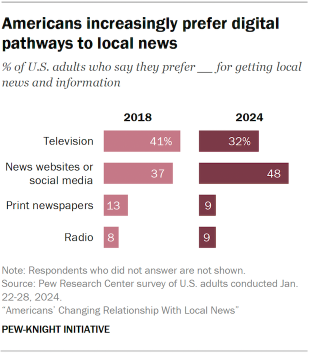
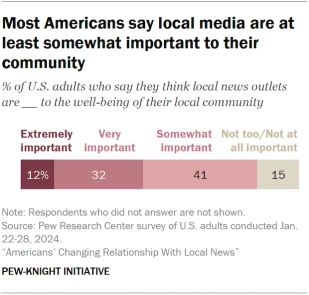
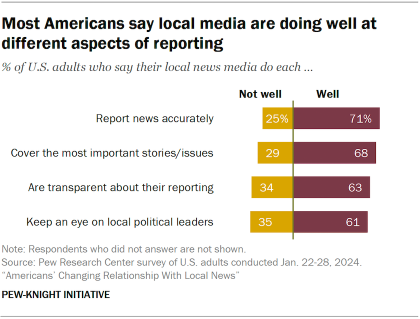
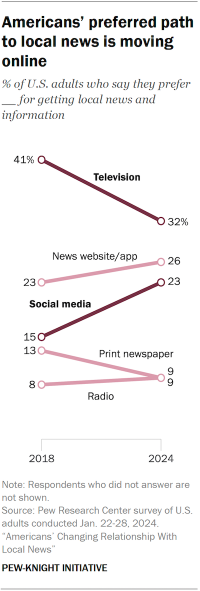
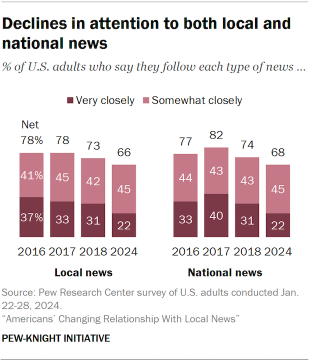
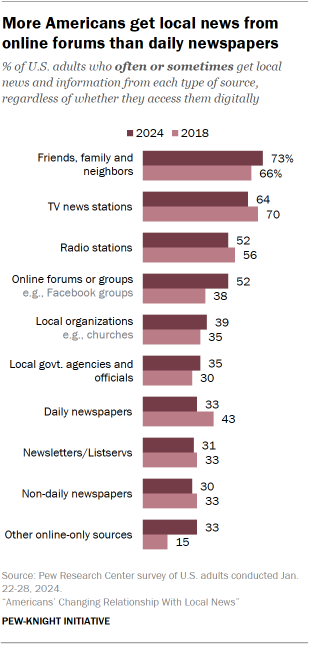
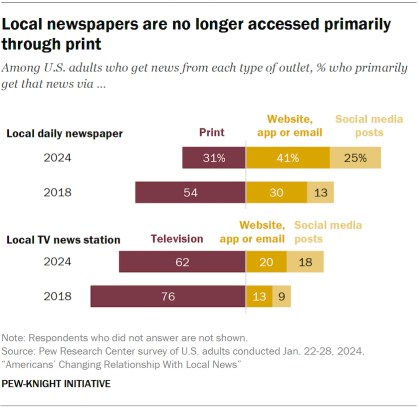
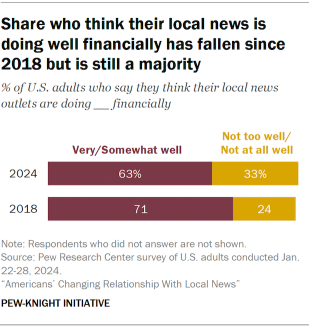
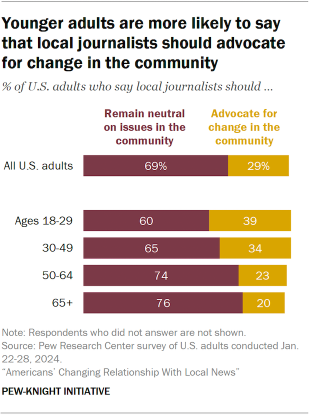
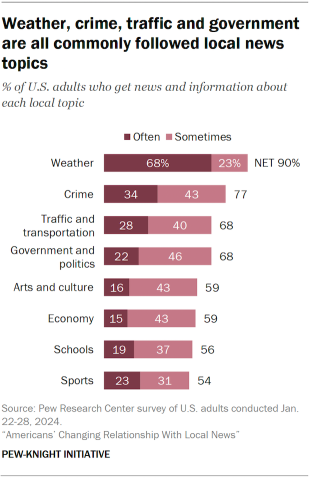



























Discussion about this post